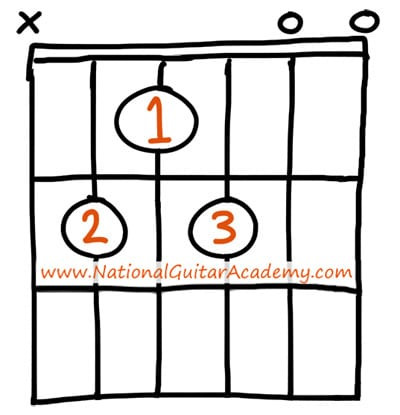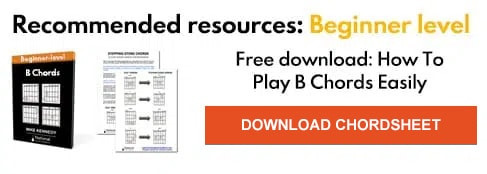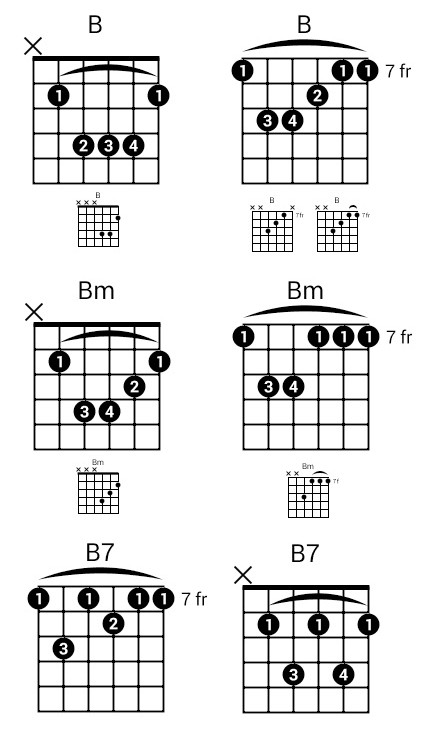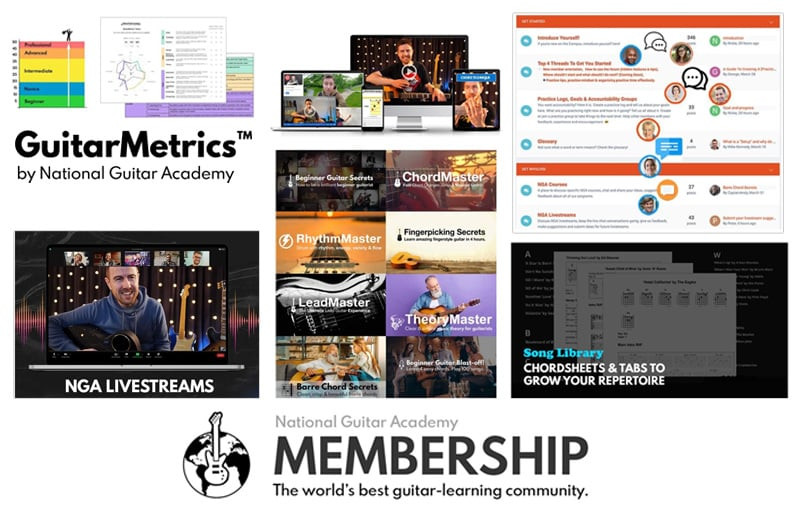The B major guitar chord is notorious for being one of the most challenging chords for beginner guitarists. Many aspiring guitar players find their progress hindered by this barre chord, often feeling frustrated and discouraged. But don’t worry, the full B chord doesn’t have to be your first step!
In this lesson, we’ll explore easier ways to play a B chord on your guitar. You’ll discover beginner-friendly versions that sound great and will help you build the finger strength and dexterity needed to eventually conquer the full B major.
In this guide, you will learn:
- The correct way to play the standard B guitar chord (and why it’s tough for beginners).
- The best easy B chord alternatives perfect for those just starting out.
- A super simple 3-string B chord version – ideal for ultimate beginners.
- Bonus tips to make any B chord version sound fantastic.
The Standard B Major Chord: Why Is It So Hard?
Before we dive into the easier options, let’s take a look at the traditional B major chord. Understanding its construction will help you appreciate the simplicity of the beginner versions we’ll explore.
B Major Chord Diagram
Alt text: B Major guitar chord diagram showing a barre chord with fingers 1, 2, 3, and 4 fretting strings on the second fret.
(If chord diagrams are new to you, check out our guide: “How To Read Guitar Chordboxes In 60 Seconds”).
Trying to play this B chord? You’re likely finding it quite difficult! The full B major chord is challenging because it’s a barre chord. This means you need to use your index finger to press down multiple strings at once across the fretboard. For beginners, this requires significant finger strength and precise finger placement, which takes time and practice to develop.
Many beginners get stuck trying to learn this chord too early. That’s why learning easier versions of the B chord is a fantastic approach. It allows you to play songs that use the B chord without the immediate frustration of the full barre.
Two Beginner-Friendly B Chord Versions: B7 and Bm11
Let’s explore two excellent alternatives to the standard B major chord, perfect for beginner guitarists: B7 and Bm11.
1. B7 Chord: The Best Beginner B Chord
The B7 chord is often considered the best easy B chord for beginners. It simplifies the standard B chord significantly while still retaining a strong B sound.
B7 Chord Diagram
 B7 Guitar Chord Diagram for Beginners
B7 Guitar Chord Diagram for Beginners
Alt text: B7 guitar chord diagram for beginners, a simplified version using three fingers on the first, second, and third strings of the second fret.
As you can see, the B7 chord is much less daunting than the full B major. It only requires three fingers and avoids the full barre.
How to play the B7 chord:
- First Finger: Place your 1st finger on the 1st string (high E string), 2nd fret.
- Second Finger: Place your 2nd finger on the 3rd string (G string), 2nd fret.
- Third Finger: Place your 3rd finger on the 2nd string (B string), 2nd fret.
- Strum: Strum from the 5th string (A string) downwards. Avoid strumming the 6th string (low E string) for this chord.
Why B7 is great for beginners:
- Fewer Fingers: It uses only three fingers, making it less cramped and easier to manage than the full B major.
- No Barre: The absence of a barre eliminates the need for significant finger strength and precise barre technique.
- Good Sound: B7 is a dominant 7th chord and sounds fantastic in many songs, providing a bluesy and jazzy flavor. It’s a musically rich and useful chord in its own right.
Practice Tip: Practice switching between the B7 chord and other easy chords you know, like E minor, C major, or G major. This will help you develop chord transitions and finger dexterity.
2. Bm11 Chord: An Even Simpler B Option
For absolute beginners, or those who find B7 still a bit challenging, the Bm11 chord offers an even simpler way to play a B-based chord.
Bm11 Chord Diagram
Alt text: Bm11 easy guitar chord diagram for beginners, using only two fingers on the first and second strings of the second fret.
The Bm11 chord is incredibly easy as it only requires two fingers!
How to play the Bm11 chord:
- First Finger: Place your 1st finger on the 1st string (high E string), 2nd fret.
- Second Finger: Place your 2nd finger on the 2nd string (B string), 2nd fret.
- Strum: Strum from the 5th string (A string) downwards. Again, avoid strumming the 6th string.
Why Bm11 is ultra-beginner friendly:
- Two Fingers Only: The minimal finger requirement makes it the easiest B chord version to fret.
- Root Note Present: Although it’s a simplified chord, it still contains the essential B root note, making it a recognizable B chord in simple song contexts.
- Stepping Stone: Think of Bm11 as a stepping stone. Once you can play this comfortably, moving to B7 will feel much more manageable.
Important Note: While Bm11 is easy to play, it’s a minor chord variation and doesn’t have the full, rich sound of B major or B7. It’s best used as a temporary substitute while you develop your skills. Aim to “upgrade” to B7 as soon as you can.
The 3-String B Chord: The Ultimate Easy B
For the most simplified B chord experience, especially suitable for children or adults with smaller hands, the 3-string B chord is a fantastic option.
3-String B Chord Diagram
 3-String B Guitar Chord Diagram
3-String B Guitar Chord Diagram
Alt text: 3-string B guitar chord diagram showing index finger barring three strings on the second fret.
This version uses only three strings and a single finger!
How to play the 3-string B chord:
- First Finger: Barre your 1st finger across the 1st, 2nd, and 3rd strings at the 2nd fret. Make sure all three strings ring clearly.
- Strum: Only strum the top three strings (1st, 2nd, and 3rd strings).
Benefits of the 3-string B chord:
- Simplest Barre: It introduces the barre concept in the easiest possible way, using only three strings.
- Minimal Finger Strength: Requires very little finger strength, making it accessible to almost anyone.
- Still a B Chord: Despite its simplicity, it’s still a valid B major chord and will work in many beginner songs.
Sound Consideration: As you might expect, the 3-string B chord sounds quite thin compared to the fuller versions. However, for very early stages of learning, it’s a great way to get playing songs quickly.
Bonus Acoustic B Chord: Bsus4
If you play acoustic guitar, you might enjoy the Bsus4 chord. It’s another easier variation that provides a lighter, more open sound, particularly well-suited for acoustic styles.
Bsus4 Chord Diagram
Alt text: Bsus4 guitar chord diagram for acoustic guitar, a four-finger chord on the second and fourth frets.
How to play the Bsus4 chord:
- First Finger: Place your 1st finger on the 1st string (high E string), 2nd fret.
- Second Finger: Place your 2nd finger on the 3rd string (G string), 2nd fret.
- Third Finger: Place your 3rd finger on the 2nd string (B string), 4th fret.
- Fourth Finger: Place your 4th finger on the 4th string (D string), 4th fret.
- Strum: Strum from the 5th string (A string) downwards. Avoid the 6th string.
Why Bsus4 is great for acoustic guitar:
- Open Sound: Bsus4 has a suspended sound, meaning it lacks the definitive major or minor tonality. This creates a spacious and airy quality, ideal for acoustic music.
- Easier Than Full B: While it uses four fingers, it avoids the full barre of the standard B major, making it more approachable.
- Acoustic Friendly: Bsus4 chords often sound particularly good on acoustic guitars, adding a unique flavor to your playing.
Common B Chord Variations
As you progress, you’ll encounter many variations of the B chord. Here are a few common types you might see:
 Common Types of B Chords on Guitar
Common Types of B Chords on Guitar
Alt text: Chart of common B chord variations on guitar, including B Major, Bm, B7, B6, Bmaj7, Bsus4, and Bsus2.
This chart shows just a few of the many ways to play B chords. Understanding these variations will expand your musical vocabulary and allow you to play a wider range of songs.
Ready to Take Your Guitar Playing Further?
- Personalized Guitar Learning: Get a custom guitar-learning plan tailored to your goals with GuitarMetrics™.
- World-Class Guitar Courses: Learn from the best instructors with our comprehensive online guitar courses.
- Join Our Community: Connect with fellow guitarists in our friendly Community Campus & Learning Forum.
- Beginner Song Library: Access songs perfect for your level with chordsheets, tabs, and helpful tips in our Beginner Song library.
- Live Learning: Participate in regular live streams, seminars, and Q&A sessions with guitar experts. Learn more about National Guitar Academy membership
 National Guitar Academy Membership Montage
National Guitar Academy Membership Montage
Show Your Guitar Love with Cool Merch!
Check out our guitar t-shirts and merchandise store
Want More Free Guitar Tips & Lessons?
Join over 100,000 guitarists and subscribe to our free guitar-tips-by-email service!
Get a series of lessons to elevate your guitar journey, learn essential fundamentals, and discover “ninja tips” for instant fun!
Explore More Popular Guitar Lessons
- How To Learn Guitar: An 11-Step Programme For Beginners
- 10 Easy Songs For Beginners
- How To Strum A Guitar
- How To Choose The Perfect Beginner Guitar
- Guitar Notes Explained: A Guide For Beginners
- How To Play Lead Guitar
- 3 Easy Ways To Play Bm
Discover More Cool Guitar Stuff
- Learn about the National Guitar Academy: About Us
- Join us on Facebook for daily guitar tips.
- Listen to our Learn Guitar Podcast for rapid guitar progress.
- Check out all our free chord lessons.
